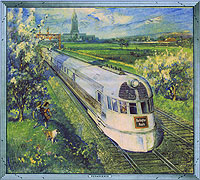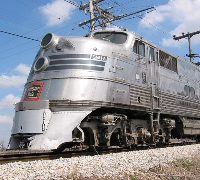The Chicago, Burlington & Quincy Railroad, the official name of the Burlington Route, started from humble beginnings February 12, 1849 in Aurora, Illinois. The Aurora Branch Railroad was laid with secondhand strap iron spiked to 12 miles of wooden rails. On September 2, 1850, the first train chugged its uncertain way over six miles from Batavia, Illinois, north to Turner Junction, and then eastward to Chicago over the tracks of the Galena and Chicago Union Railroad. The locomotive and cars were borrowed from the Galena line as their own equipment had not yet arrived. This allowed the Aurora Branch to be the second railroad to serve Chicago.
By 1864, the railroad had 400 miles of track - all in Illinois - and adopted the familiar name Chicago, Burlington & Quincy Railroad Co., which properly described its trackage stretching to Burlington, Iowa and Quincy, Illinois on the Mississippi River. The name also had staying power, for it lasted 106 years until the Burlington Northern merger in 1970.
The Burlington, as it came to be known, completed its own line from Aurora to Chicago in 1864, and the following year had the distinction of operating the first train into the newly-opened Union Stock Yards.
Burlington's rapid expansion after the Civil War was based upon sound financial management, dominated by John Murray Forbes of Boston and assisted by Charles E. Perkins. Perkins was a powerful administrator who eventually forged a system out of previously loosely-held affiliates, virtually tripling Burlington's size during his presidency from 1881 to 1901.
The railroad across Iowa was the Burlington and Missouri River Railroad, incorporated in Burlington in 1852. Operations began over the first few miles of track on New Year's Day, 1856. The road reached Ottumwa by September 1, 1859, where track-building stalled until after the Civil War, finally being completed to the Missouri River in January 1, 1870. The trains of that day were pulled by small, wood-burning locomotives, only capable of pulling a dozen or so cars. The passenger cars were built of wood and were not very comfortable for the traveler.
In 1868 the CB&Q completed bridges over the Mississippi both at Burlington and Quincy, giving the railroad through connections with the B&MR in Iowa and the Hannibal & St, Joseph Railroad in Missouri. The first Railway Post Office was inaugurated on the H&St.J to sort mail on the trains way across Missouri, passing the mail to the Pony Express upon reaching the Missouri River. The B&MR continued building westward into Nebraska as a separate company, the Burlington & Missouri River Rail Road in Nebraska, founded in 1869. On July 26, 1870 it reached Lincoln, the newly designated capital of Nebraska and by September 3, 1872 it reached Kearney, Nebraska. That same year the B&MR across Iowa was leased to the CB&Q and three years later it was deeded to the CB&Q. By the time the Missouri River bridge at Plattsmouth was completed the B&MR in Nebraska was well on its way to the Mile High city of Denver, Colorado. That same year, the Nebraska B&MR was purchased by the CB&Q which completed the line to Denver by 1882, the first direct rail line from Chicago to Denver.
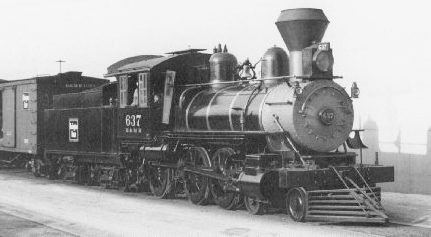 By this time, the steam locomotives used coal as their fuel and became considerably larger. More emphasis was placed on the comfort and safety of the passenger with larger, more plush coaches. Trains no longer stopped at large stations to allow the passengers to get a meal, dining cars for meals while traveling were now in common use. By this time, the steam locomotives used coal as their fuel and became considerably larger. More emphasis was placed on the comfort and safety of the passenger with larger, more plush coaches. Trains no longer stopped at large stations to allow the passengers to get a meal, dining cars for meals while traveling were now in common use.
As the Burlington lines were pushing westward, other segments were built in the Midwest, notably links to St. Louis and Rock Island. The idea of building north to the Twin Cities was also gaining momentum. In 1885, lines were extended to Savanna, Illinois, then north along the Mississippi River to St. Paul in 1886.
Throughout the years, products from farms and ranches were essential to the CB&Q, and the company became known as a "Granger Railroad." Burlington representatives worked closely with farmers and ranchers, and as early as 1854 the railroad advised prospective settlers on what crops could be successfully raised in Missouri. Alfalfa was introduced by the railroad as a commercial crop in 1875. Crop and stock improvement, irrigation and soil conservation were aggressively promoted. Through seed and soil exhibits, poultry specials and livestock trains, the Burlington helped bring the most advanced agri-science directly to the farmer. Burlington often would employ farmers at shop work during the winter months until they were able to establish their farms and attend to them on a full-time basis. |
The turn of the century brought about the purchase of the CB&Q by railroad "Empire Builder," James J. Hill, founder of the Great Northern Railroad. Hill's Great Northern and Northern Pacific railroads purchased 97.2 percent of the CB&Q's common stock, paying $200 per share.
Always anxious to employ the latest technology, Burlington operated the first printing telegraph in 1910, and in 1915 was the first railroad to use train radio. In 1927, the Burlington was one of the first to utilize centralized traffic control and by the end of 1957 had equipped 1,500 miles of track for this advanced type of signaling.
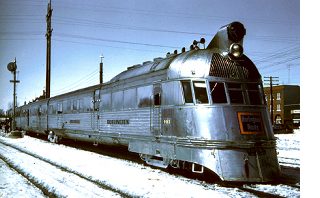 Perhaps the Burlington's best known achievement took place in 1934 with the introduction of the Pioneer Zephyr - America's first diesel-powered streamlined passenger train. Its high-speed diesel-electric propulsion system was the forerunner of thousands of diesels that replaced steam locomotives on virtually every railroad a few short years after WWII. On May 26, 1934, the Burlington staged one of the greatest transportation events of the Thirties - a 1,000-mile record breaking, non-stop run from Denver Colorado to the World's Fair on Chicago's lake front, where the Pioneer Zephyr climaxed the "Wings of a Century" transportation pageant. News bulletins had been broadcast throughout the day as the train streaked through villages and cities, including Murray. The highest speed attained was 112.5 miles per hour and the total fuel cost for the trip was $14.64! Perhaps the Burlington's best known achievement took place in 1934 with the introduction of the Pioneer Zephyr - America's first diesel-powered streamlined passenger train. Its high-speed diesel-electric propulsion system was the forerunner of thousands of diesels that replaced steam locomotives on virtually every railroad a few short years after WWII. On May 26, 1934, the Burlington staged one of the greatest transportation events of the Thirties - a 1,000-mile record breaking, non-stop run from Denver Colorado to the World's Fair on Chicago's lake front, where the Pioneer Zephyr climaxed the "Wings of a Century" transportation pageant. News bulletins had been broadcast throughout the day as the train streaked through villages and cities, including Murray. The highest speed attained was 112.5 miles per hour and the total fuel cost for the trip was $14.64!
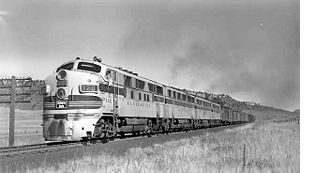 Burlington's first freight diesels were purchased in 1944, and 95 percent of its trains were dieselized by 1953. In 1945, Burlington created America's first vista-dome passenger car, and in 1950, it ushered in the age of modern commuting, bringing to Chicago America's first double-deck, stainless steel suburban equipment. Some of the Burlington's passenger trains were the Denver Flyer, the Aristocrat, the Blackhawk, the Pioneer Zephyr, the Twin Cities Zephyr, the Mark Twain Zephyr , the General Pershing Zephyr, the Kansas City Zephyr, the American Royal Zephyr, the Denver Zephyr, the Nebraska Zephyr, the Ak-Sar-Ben Zephyr, the Texas Zephyr, the Sam Houston Zephyr and the Fast Mail. The Burlington also ran other famous trains in cooperation with other railroads. Some of those were the Exposition Flyer, California Zephyr, the Zephyr-Rocket, the Twin Star Rocket, the Empire Builder, the North Coast Limited, The Mainstreeter and the Western Star. Burlington's first freight diesels were purchased in 1944, and 95 percent of its trains were dieselized by 1953. In 1945, Burlington created America's first vista-dome passenger car, and in 1950, it ushered in the age of modern commuting, bringing to Chicago America's first double-deck, stainless steel suburban equipment. Some of the Burlington's passenger trains were the Denver Flyer, the Aristocrat, the Blackhawk, the Pioneer Zephyr, the Twin Cities Zephyr, the Mark Twain Zephyr , the General Pershing Zephyr, the Kansas City Zephyr, the American Royal Zephyr, the Denver Zephyr, the Nebraska Zephyr, the Ak-Sar-Ben Zephyr, the Texas Zephyr, the Sam Houston Zephyr and the Fast Mail. The Burlington also ran other famous trains in cooperation with other railroads. Some of those were the Exposition Flyer, California Zephyr, the Zephyr-Rocket, the Twin Star Rocket, the Empire Builder, the North Coast Limited, The Mainstreeter and the Western Star.
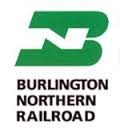 On March 2, 1970, the Chicago, Burlington & Quincy Railroad became a part of the Burlington Northern Railroad, which merged the CB&Q with its owners, the Great Northern and the Northern Pacific. Shortly thereafter, America's passenger trains were nationalized with the creation of Amtrak. The silver, stainless steel Zephyrs gave way to a rainbow of equipment from railroads across the nation. On March 2, 1970, the Chicago, Burlington & Quincy Railroad became a part of the Burlington Northern Railroad, which merged the CB&Q with its owners, the Great Northern and the Northern Pacific. Shortly thereafter, America's passenger trains were nationalized with the creation of Amtrak. The silver, stainless steel Zephyrs gave way to a rainbow of equipment from railroads across the nation.
The BN painted the Burlington's bright Chinese Red locomotives Cascade Green and they continued pulling freight trains of all kinds. The most frequent train of the modern age are unit trains of coal, grain and inter-modal containers. Then on, September 22, 1995, another merger took place, combining the BN with the Atchison, Topeka & Santa Fe Railroad creating the current BNSF railroad. |
